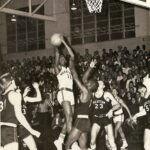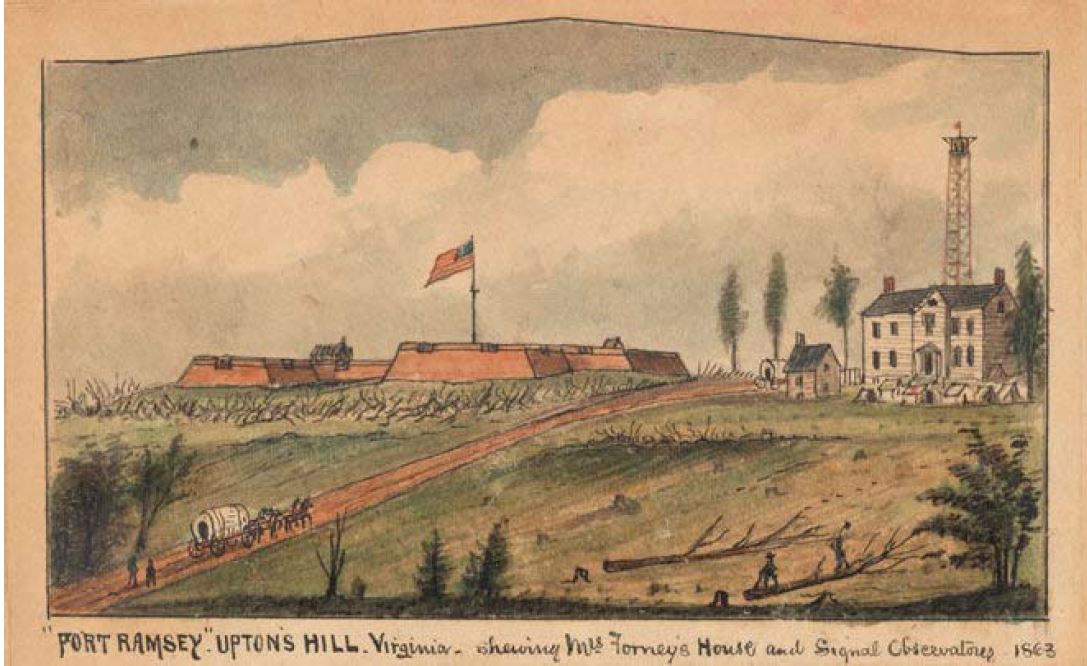
The Arlington Historical Society greatly appreciates Mr. Dean DeRosa’s expertise and time in preparing this article and allowing us to present it here on the AHS website.
Three elderly gentlemen, circa 1918. Their photos are not unlike the images many today might find in their old, treasured family albums. Two of the gentlemen would leave little historical record but extensive and proud families in the Pacific Northwest. The third gentleman would leave no posterity, but an important historical record of his time. Paraphrasing his own words, the third gentleman would leave no family, but the record of a good soldier!
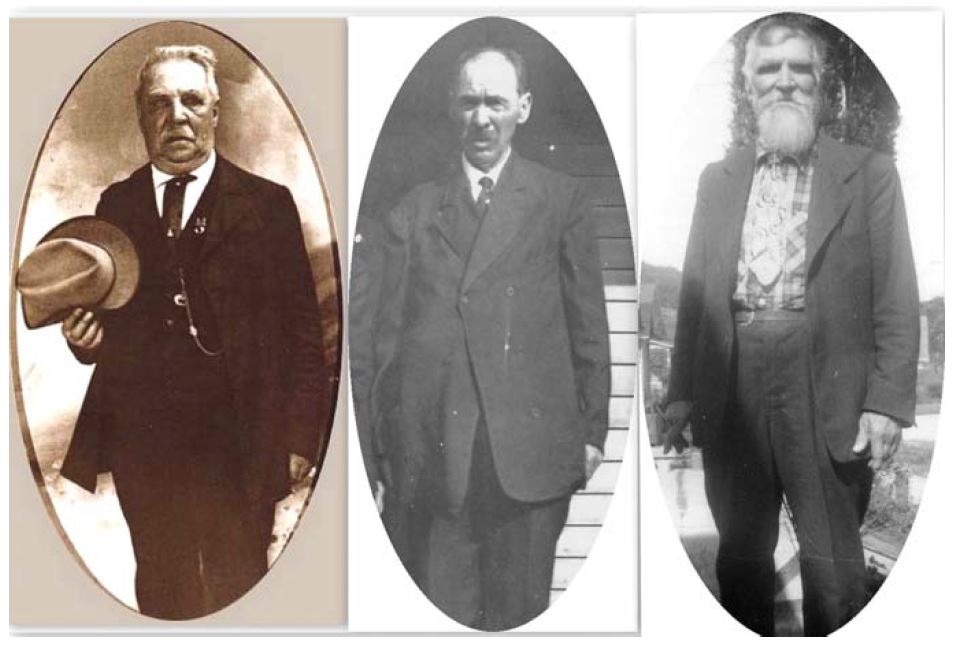
Robert Knox Sneden (1832-1918) was an architectural draftsman and American landscape artist. During the Civil War he served as a private in Company D of the 40th New York Infantry and as a topographical engineer in the Third Corps of the Army of the Potomac .
He would survive the Civil War and remain unmarried throughout his life. He died nearly a pauper at the Soldiers’ Home in Bath, N.Y., in 1918. However, he was a good soldier, and left a good war record.
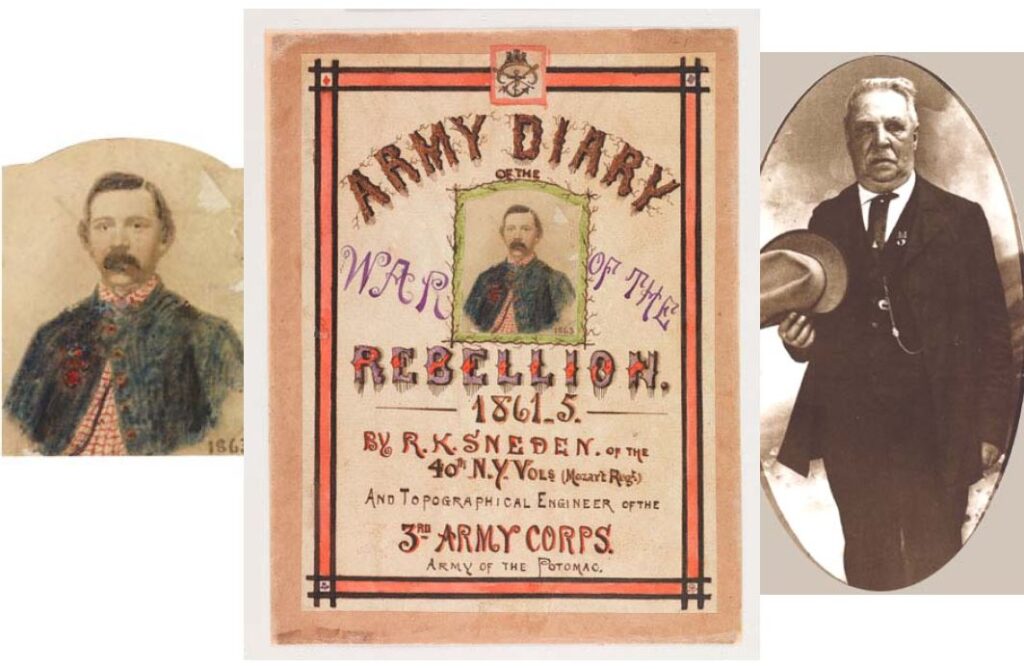
Specifically, he left a personal diary of nearly 5,000 pages containing detailed watercolor paintings, maps, and sketches of Civil War battlefields, landscapes and prisons – including Crew & Pemberton Prison in Richmond, VA, and Andersonville Prison in Georgia where he was incarcerated after his capture by John Mosby and the “Grey Ghost’s” band of rangers in November 1863.
Sneden’s Diary, consisting of several volumes – the largest collection of its kind covering the Civil War, was acquired by the Virginia Historical Society in the 1990s. The diary is the basis of two VHS-sponsored books: Charles F. Bryan, Jr. and Nelson D. Lankford, eds., Eye of the Storm: A Civil War Odyssey (New York: Free Press, 2000); and Charles F. Bryan, Jr., James C. Kelly, and Nelson D. Lankford, eds., Images from the Storm (New York: Free Press, 2001).
Sneden Chronology 1861-1864
- Aug 1861, Arrives Camp Sackett, 40th NY Regt
- Jan 1862, Topographical engineer, Ft Lyon
- Apr-Aug, Peninsula, Seven Days & 2nd Bull Run campaigns
- Oct-Nov, Joins Gen. Heintzelman, Defenses of Washington (DOW), Arlington House
- Dec, DOW, 15th & Penn
- Aug 1863, Joins 3rd Corps, Army of Potomac
- Oct-Nov 1863, Brandy Station: Mails diaries & drawings home
- Nov 27, Captured by Mosby’s Rangers, Battle of Mine Run
- Nov 30, Crew & Pemberton Prison, Richmond, VA
- Feb 1864, Andersonville Prison, GA
- Nov 12, Signs parole, medical aide, Savannah, GA
- Dec 11, Exch’d, Florence, SC
- Dec 26, Arrives home to NY
Over a period of three and half years, Sneden saw action in a number of major battles fought in Virginia. As a member of General Heintzelman’s Defenses of Washington staff located at Arlington House (1862) and Washington, DC (1863), he would travel widely around the Capital and the Northern Virginia area.
Presented here are some of Sneden’s watercolor landscapes and other illustrations of his travels in and around the City of Washington, and especially those relating to Arlington House, the home of Robert E. Lee and his family, where Sneden would be stationed during the Fall of 1862.

On enlistment, Sneden would serve as the regiment’s assistant quartermaster.
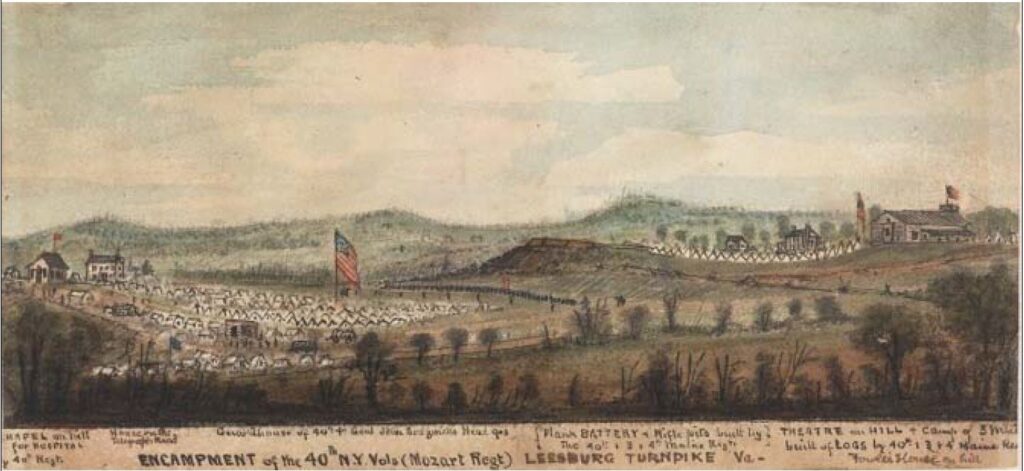
Sneden arrived in the Washington area with the 40th NY Infantry in August 1861. The Mozart Regiment established its camp along the Leesburg Turnpike, just outside of Alexandria.
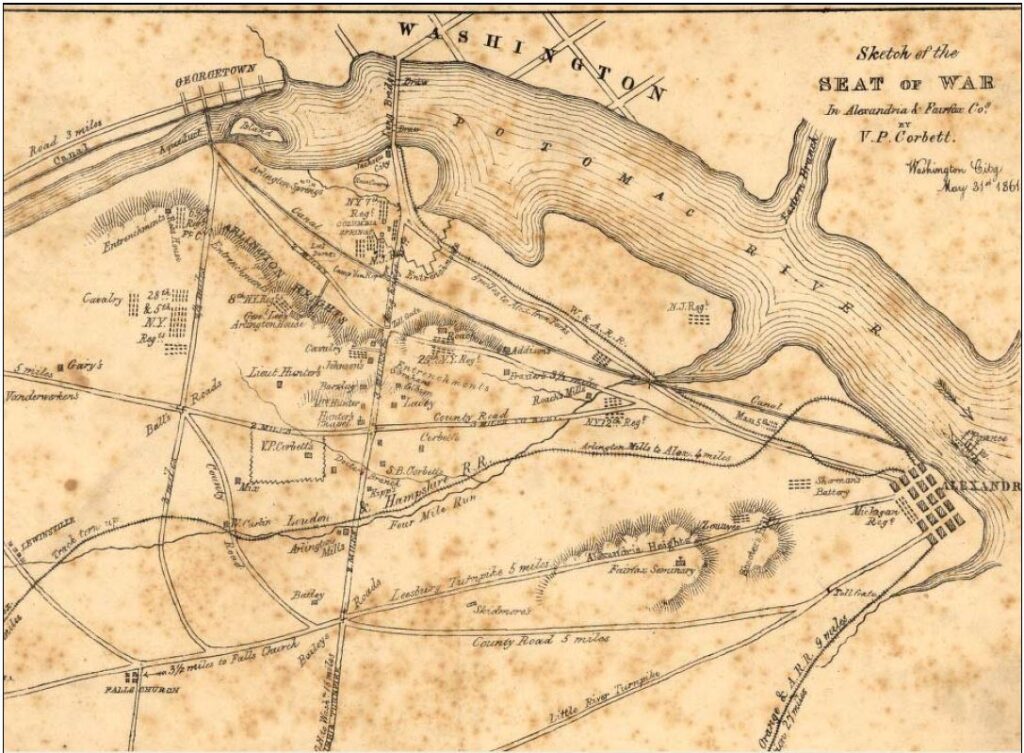
AIn addition to the cities of Alexandria, Georgetown & Washington, note several landmarks: Arlington House and Arlington Springs, Aqueduct Bridge and Long Bridge, Fairfax Seminary, Arlington Mill, Baileys Crossroads, Falls Church, major roads (Fairfax County Road–Glebe Rd, Leesburg Pike, Columbia Pike, and Little River Turnpike) and principal railways (Loudoun & Hampshire RR and Orange & Alexandria RR).

Alexandria was a site of Virginia secessionist unrest at the outset of the Civil War, with the killing of Col. Elmer Ellsworth at the Marshall House hotel (today, the Monaco Hotel) in late-May 1861.
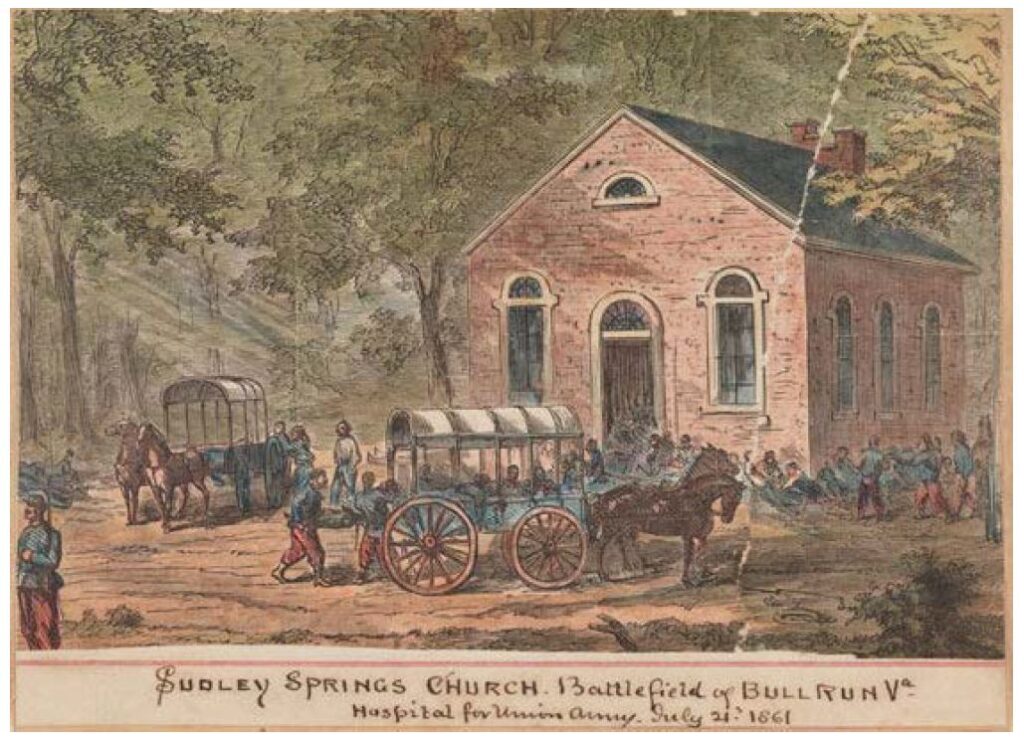
The Civil War would commence in earnest in the Northern VA area with the First Battle of Bull Run on July 21, 1861.

After the First Battle of Bull Run, the Alexandria-Arlington area appeared as it does in this map. Note Confederate forces hold several key positions, especially the high ground along Leesburg Pike (Munson and Upton Hills). The rebels also made forays along the Old Fairfax County Road (today Glebe Road), burning prominent houses along the way, for instance, the Hall house near Mt Olivet Church and the present day Arlington Hospital.

Among the most prominent positions held by the Confederates threatening Washington was Munson’s Hill overlooking Leesburg Pike–today the Seven Corners area. The rebels hoisted a large Confederate flag atop the hill that could be seen from across the Potomac in the Capital. Sneden presumably witnessed this scene first hand, from a position near Bailey’s Corner–somewhere beyond the 40th NY regiment’s encampment. When the Confederate troops abandoned Munson’s Hill, the Union troops found “Quaker guns” instead of abandoned canon. [Quaker guns were used as a deception tactic and were simply wooden logs painted black to look like a real canon. They were an effective way to misleading the enemy about the strength of an emplacement. They were named for “Quakers” or the Religious Society of Friends or “Quakers” who traditional oppose war and violence. ]
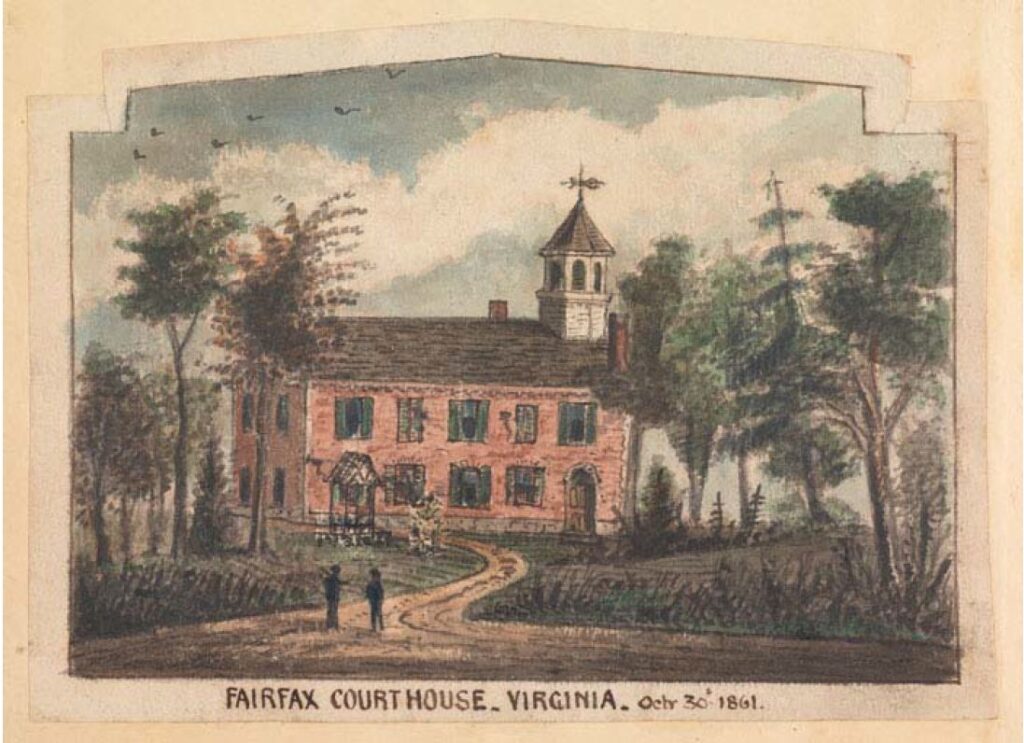
Confederate forces would finally withdraw, allowing Union troops to occupy Fairfax City and begin better protecting and fortifying the City of Washington, namely, through the construction of forts surrounding the Capital under the so-called Defenses of Washington command—first headquartered at Arlington House.
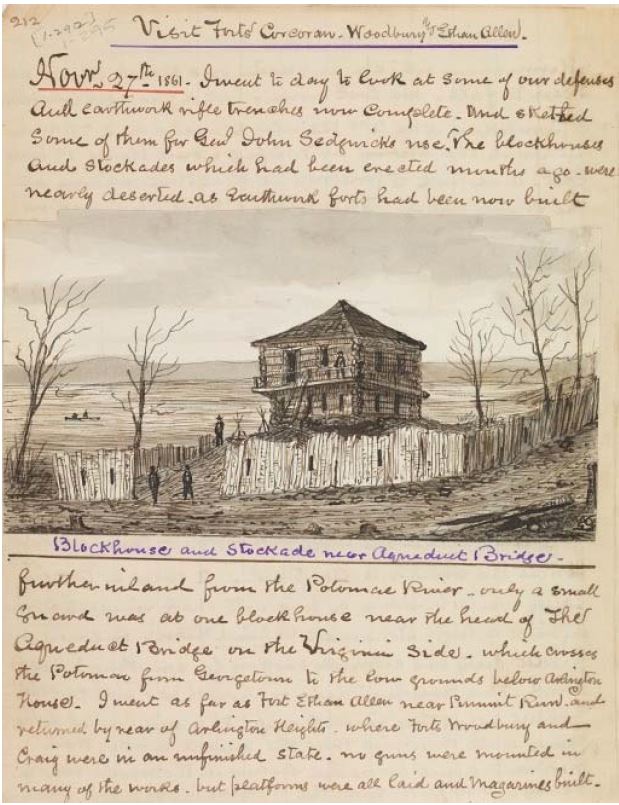
In his account from his diary, Sneden writes:
“Nov 27th 1861 – I went today to look at some of our defenses and earthwork rifle trenches now complete. And sketched some of them for Gen. John Sedgwick’s use. The blockhouse and stockades which had been erected months ago were nearly deserted as earthwork forts had been now built further inland from the Potomac River – only a small guard was at one blockhouse near the head of the Aqueduct Bridge on the Virginia side. which crosses the Potomac from Georgetown to the low grounds below Arlington House. I went as far as Fort Ethan Allen near Pimmit Run and returned by rear of Arlington Heights where Forts Woodberry and Craig were in an unfinished state. No guns were mounted in many of the works, but platforms were all laid and magazines built.”
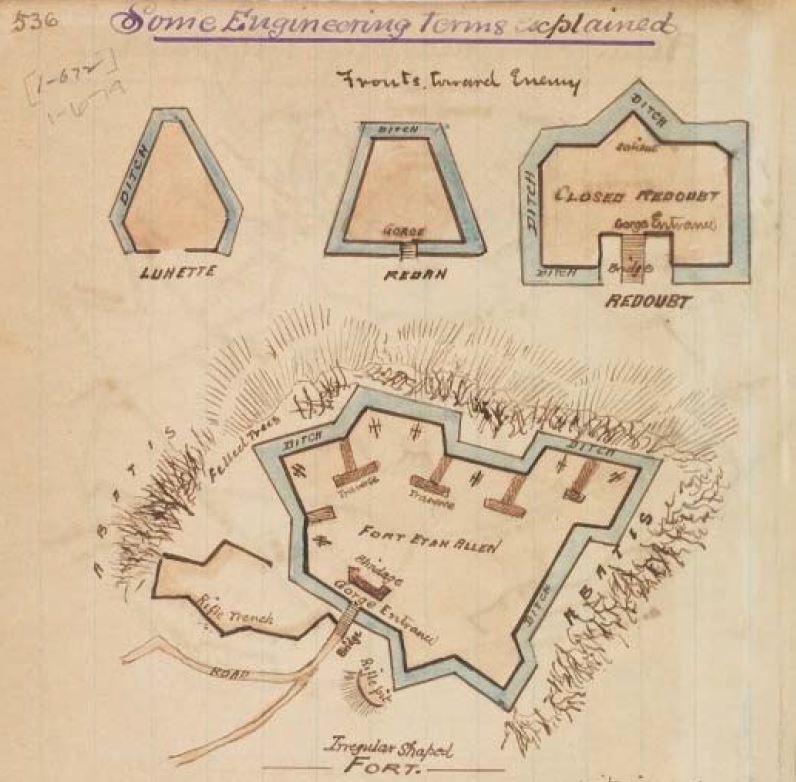
Different types of fortifications were used by the Defenses of Washington. Here Sneden illustrates some basic designs, highlighting the irregular design of Fort Ethan Allen whose remnants today are found in Arlington along the northern stretches of Old Glebe Road.
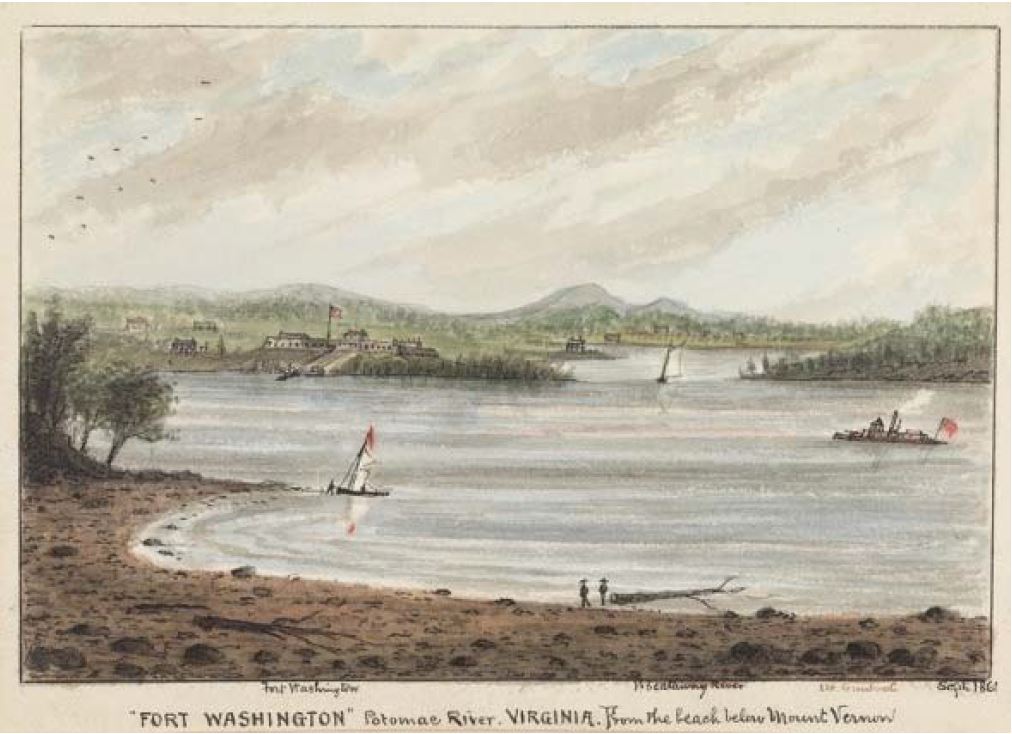
Fort Washington along the Potomac River, just opposite Mount Vernon. Fort Washington was the only major fortification protecting the City of Washington at the outbreak of the Civil War – a vestige of the War of 1812.
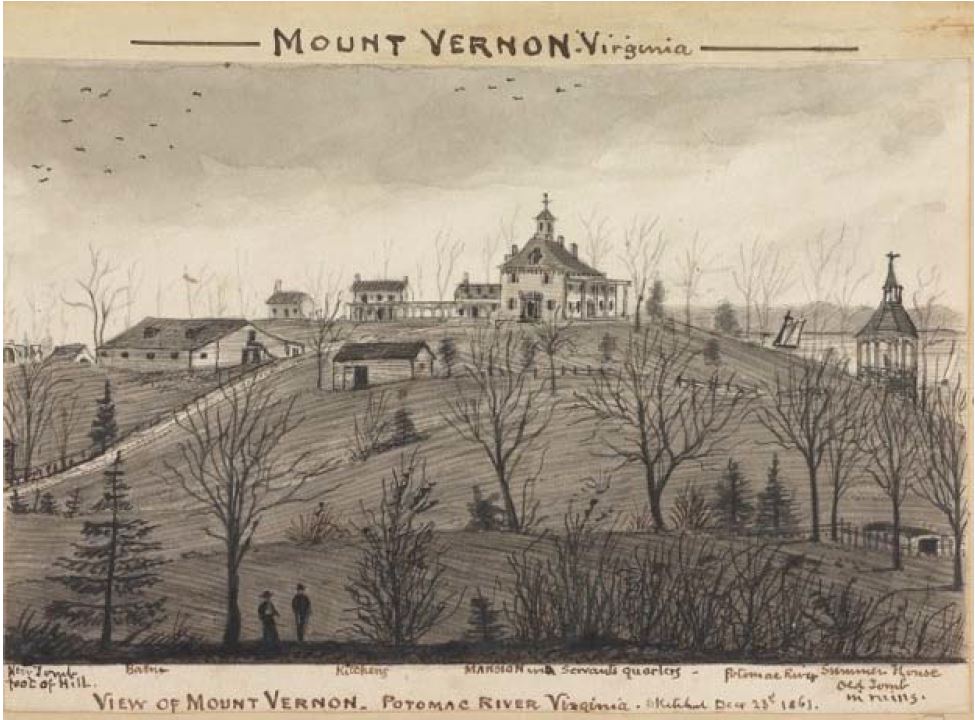
Mt Vernon as viewed by Sneden in December 1861. Both Confederate and Union forces respected the grounds of George Washington’s home. The mansion and surrounding 200 acres were purchased from John Augustine Washington, Jr., a great-great-nephew of George Washington, by the present-day Mt Vernon Ladies’ Association in 1858, for $200,000.

In January 1862, Sneden joined the staff of Gen Samuel Heintzelman at Ft. Lyon as a topographical engineer or map maker. This scene shows Ft Lyon at right, with the City of Alexandria in the background and roads to Union encampments in the middleground (Leesburg Pike and Little River Turnpike).
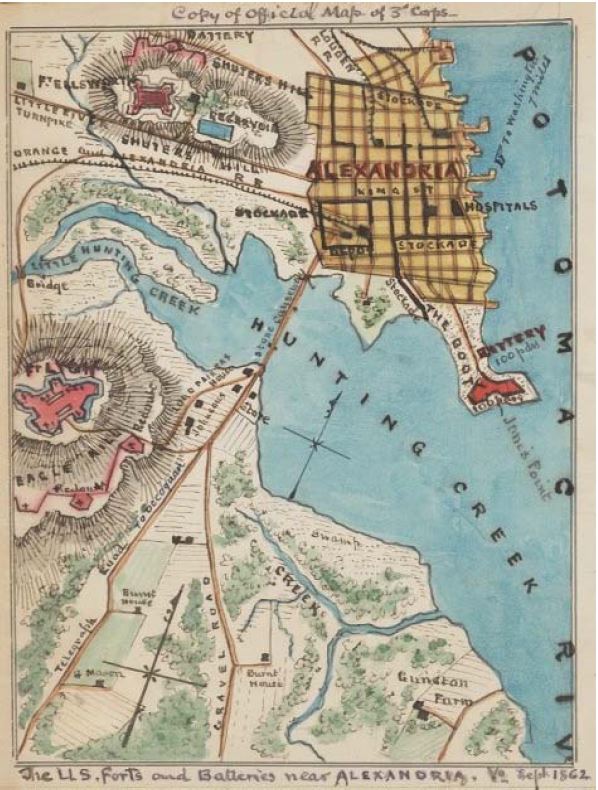
Map of Ft Lyon in relationship to the City and Port of Alexandria.
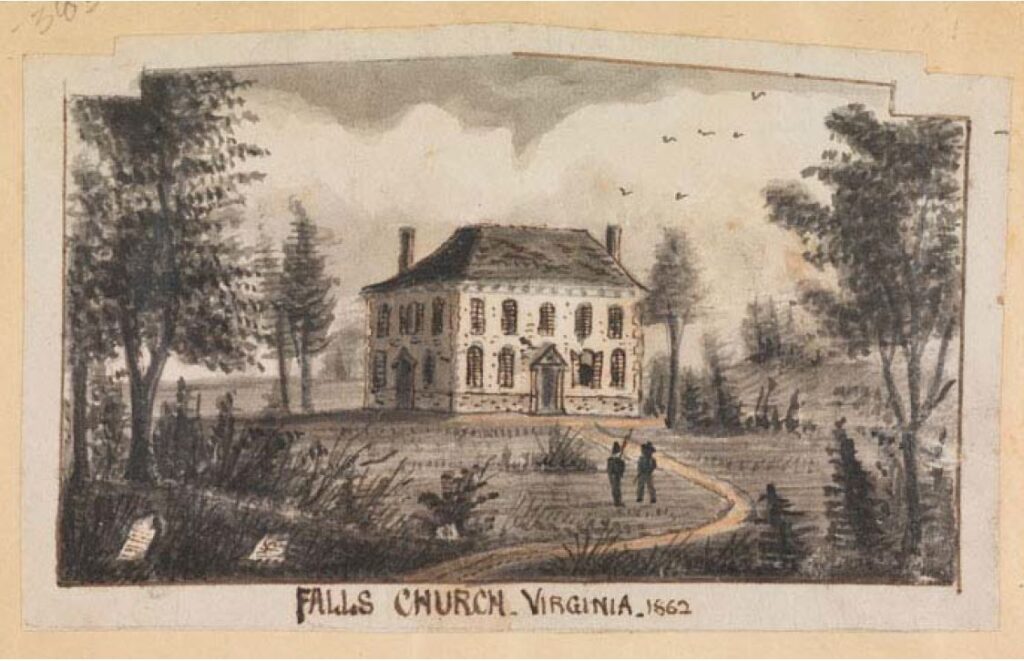
A view of Falls Church in 1862. As a cartographer, Sneden had the opportunity to travel widely around the areas of Northern Virginia held by Union forces.
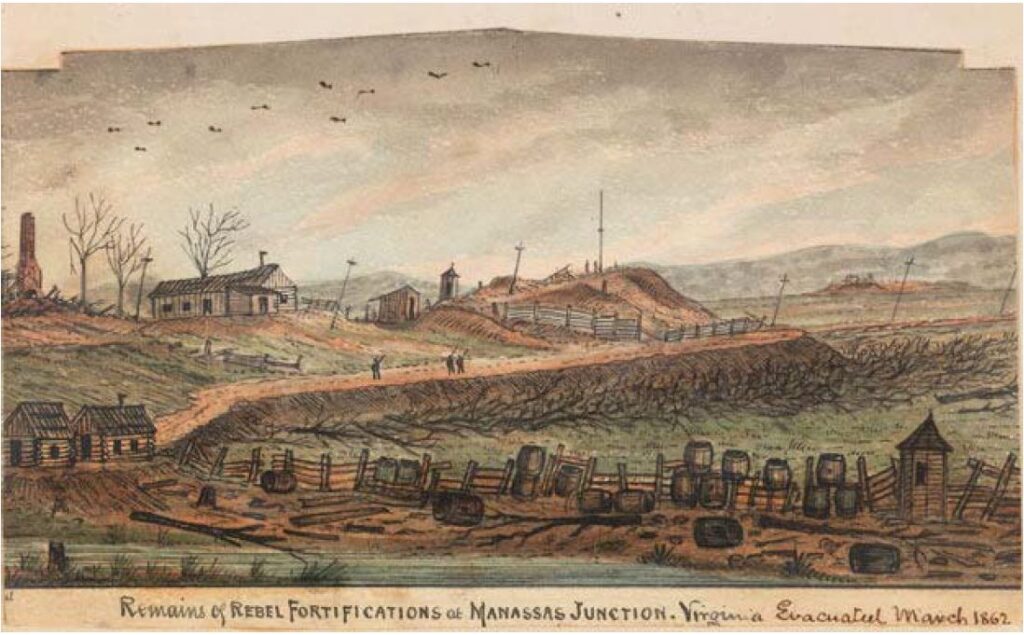
Manassas Junction and the fortifications left by Confederate troops, March 1862.
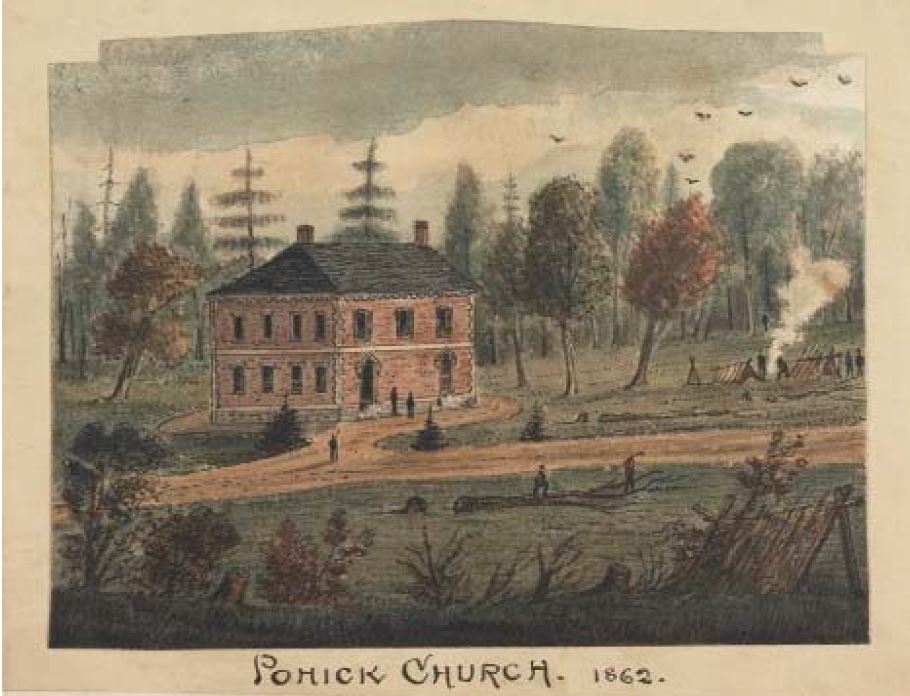
Closer to Alexandria and not distant from Mt Vernon, Pohick Church in 1862, where George Washington and his family, George Mason, William Fitzhugh, and other early patriots worshipped. The church survives today, but still bears the scars of abuse by Union troops encamped on the church grounds during the Civil War.
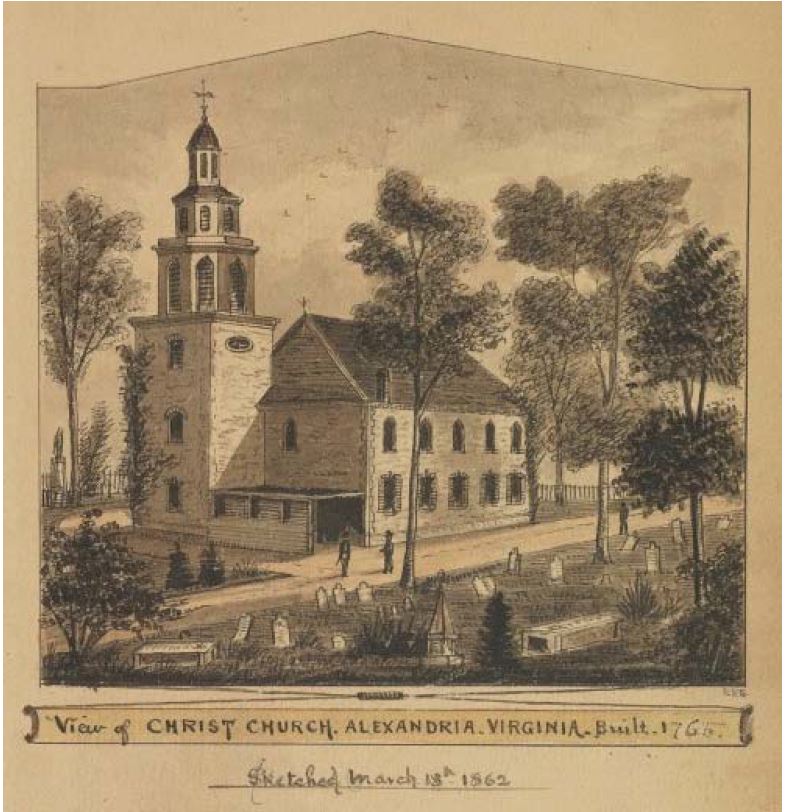
In Alexandria itself, Sneden’s view of Christ Church in 1862 where George Washington, the Custises, and the Lees worshipped. On his visit to the site, Sneden notes the church pews used regularly by the Washingtons and the Lees.
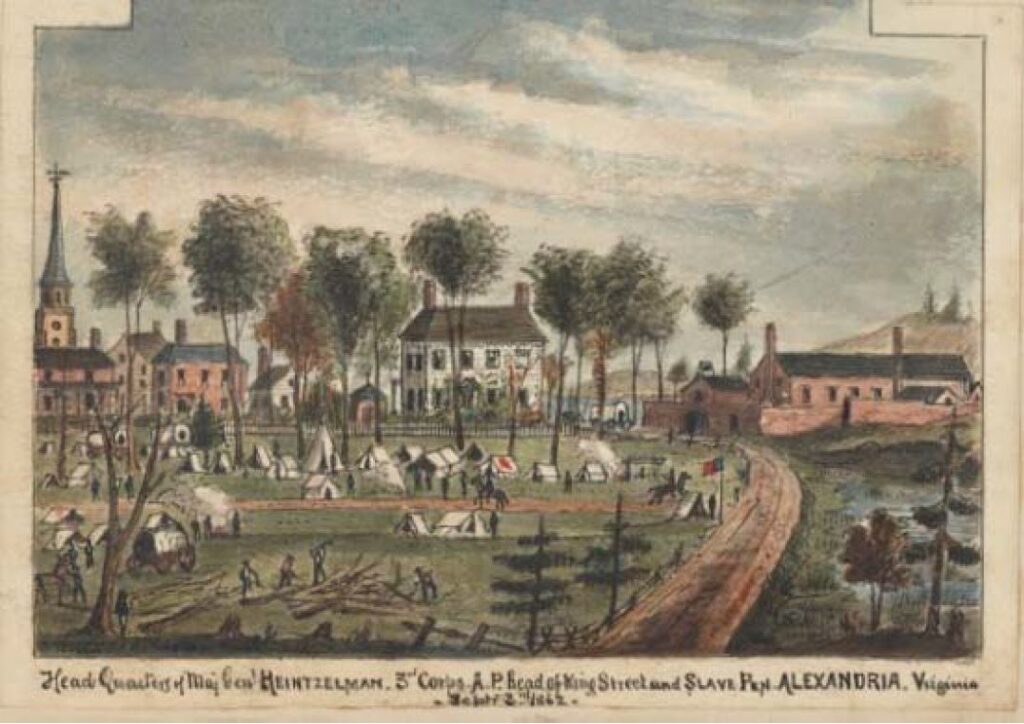
Heintzelman headquarters and the slave Pen on King Street in Alexandria, February 1862.

Another view of the Alexandria slave pen in 1862.
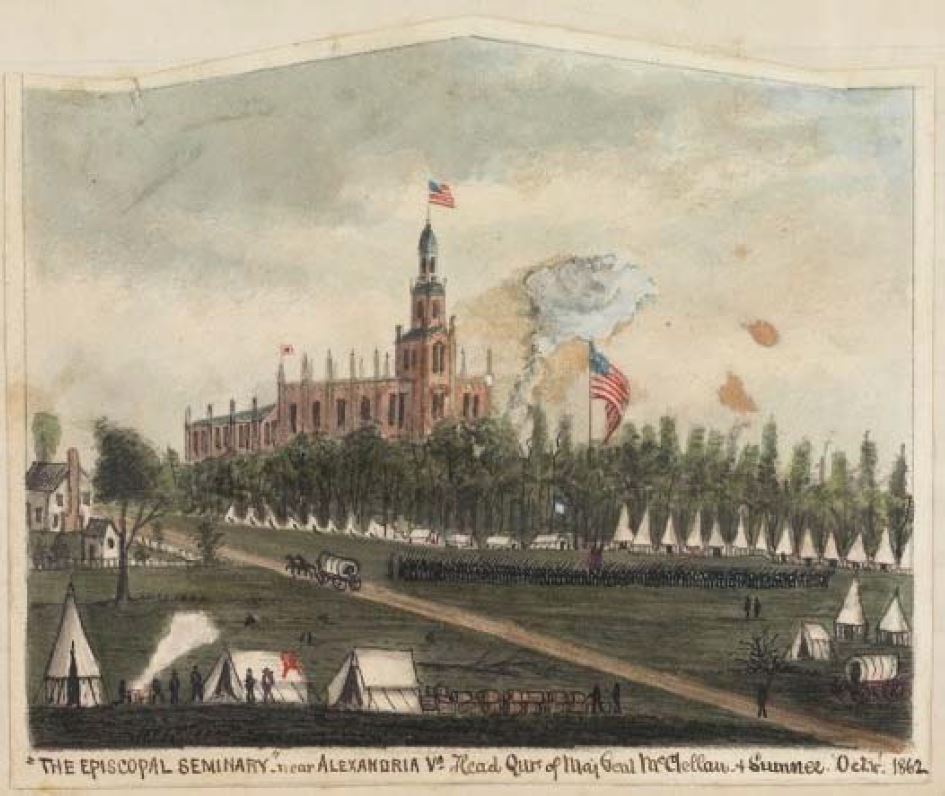
The Fairfax Episcopal Seminary (on Seminary Road) located near Alexandria, 1862. Recall that Rev. Reuel Keith, who performed the marriage of Robert E. Lee and Mary Custis at Arlington House on June 30, 1831, journeyed to Arlington Plantation from this seminary.

Sneden would participate in the Second Battle of Bull Run, in August 1862. Here Sneden depicts the destruction of railroad cars by Confederate troops at Manassas Junction.
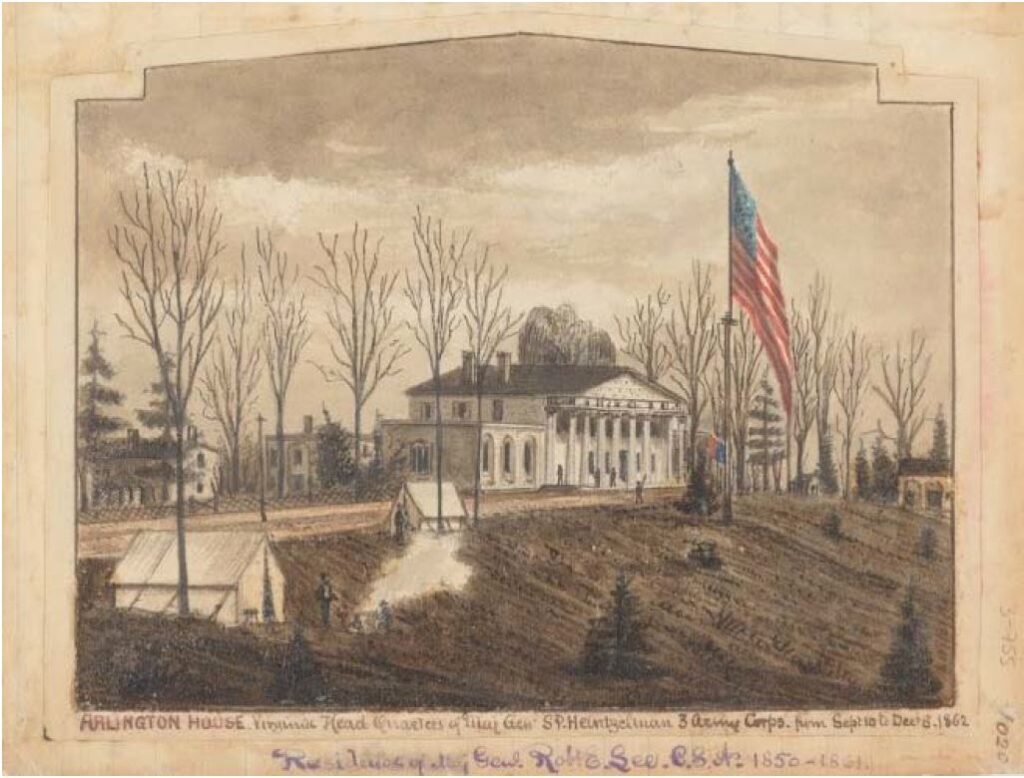
In October 1862, Gen Heintzelman takes command of the Defenses of Washington, with headquarters at Arlington House. Sneden occupies a tent on the grounds but has access to the mansion, presumably to conduct his mapmaking and other staff activities. Notice the outbuildings appear different than today. Also, the south wing of the mansion is missing its chimney.

North perspective of Arlington House (the watercolor is mislabeled). Note the tomb of Mary Randolph in the foreground at the left. Also (again), the north wing of the mansion is missing its chimney. One can also make out in the distance what appears to be the octagonal “summer house” situated in the flower garden on the south side of the mansion.
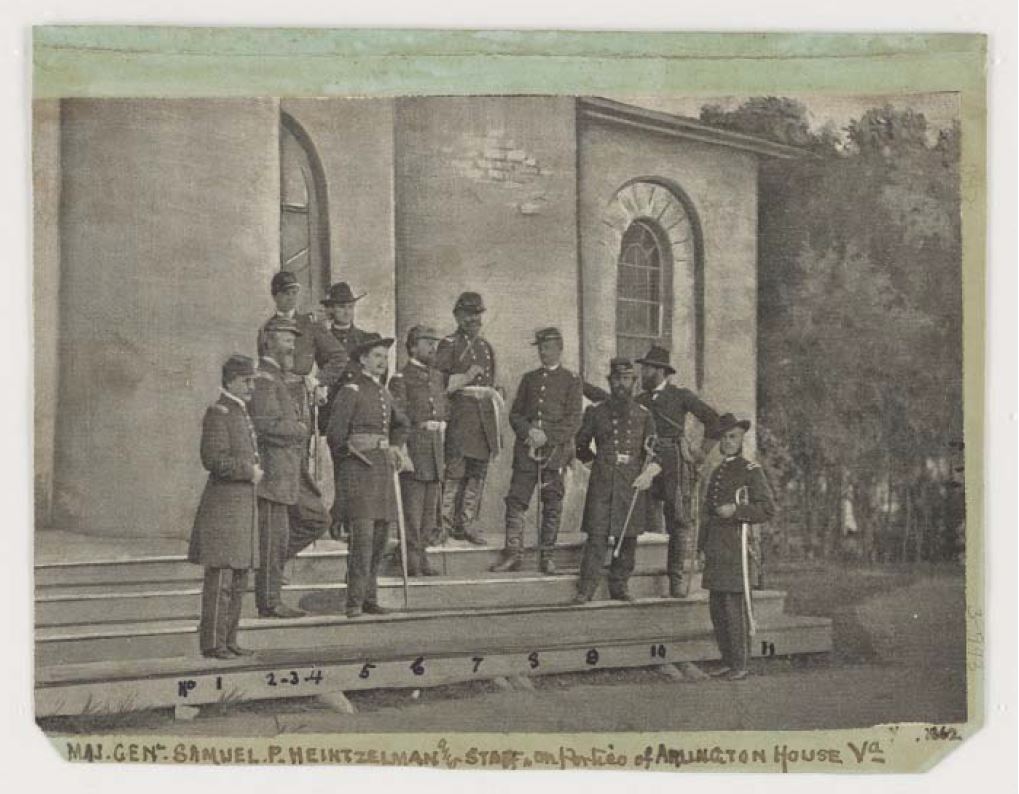
Within Arlington House, Sneden reports that a number of Washington relics are still to be found, including in the attic where Sneden rummages around and even “confiscates” several items. Among the items he finds in the attic are old and antique furniture, fire screens, lamps, old pictures, military books and several trunks full of Gen Lee’s letters 20 or more years old.

Sneden also discusses the GWP Custis paintings of Revolutionary War battles, noting the most prized ones in the series had already been removed from the mansion and placed on display at the Patent Office. Others in the series, it seems, may have been left behind at the mansion. And Sneden is certainly familiar with the September 1853 Harper’s Magazine article by Benson Lossing about Arlington House and its treasures, because he includes in his diary engravings of the Custis paintings and select Washington relics (Martha Washington’s strong box and the Washington bed) from the article. The engravings and their descriptions are apparently clipped and transcribed, respectively, directly from the Lossing article, possibly using a copy of Harper’s Magazine found within the mansion.
From Sneden’s account, it seems that Mr. Custis’ paintings were not taken by Mrs. Lee in her flight from Arlington House in mid-May 1861.
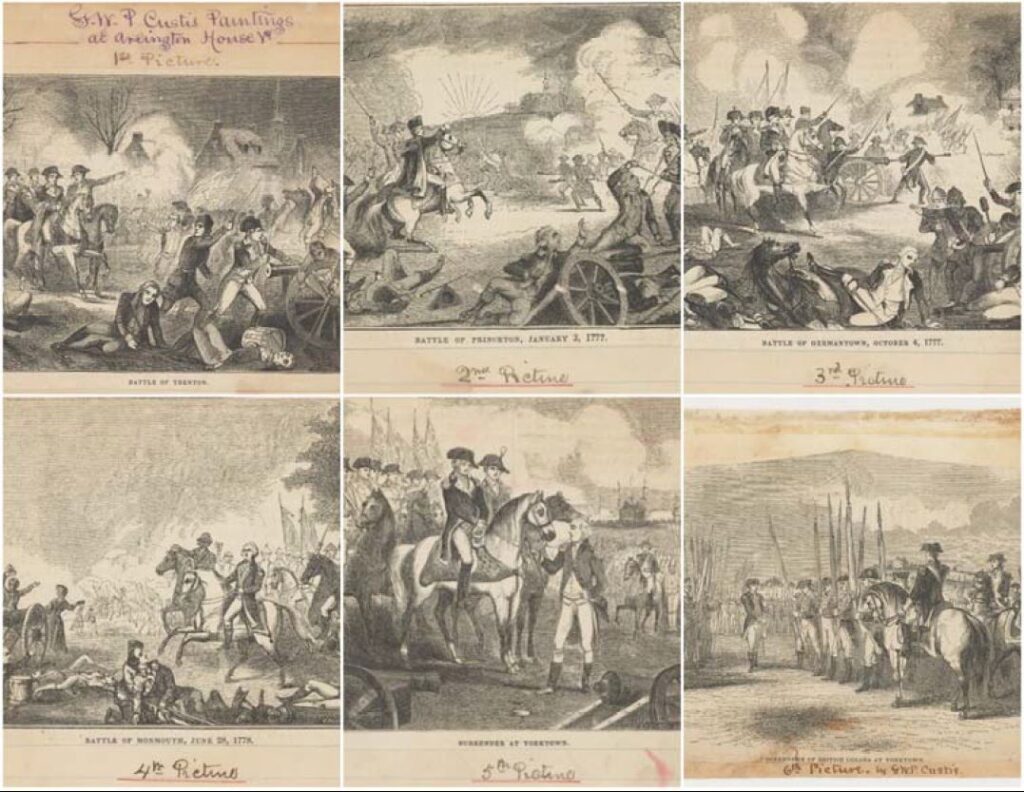

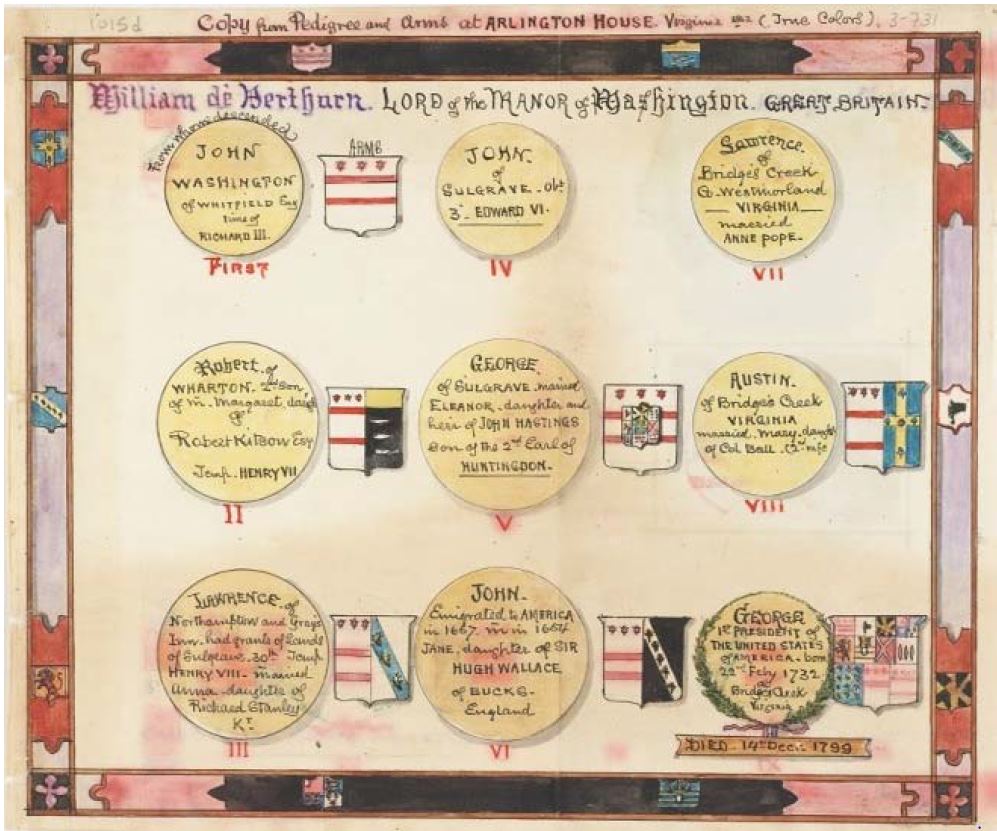

Battle of Yorktown engraving, cut by Sneden from a book found in the library at Arlington House.
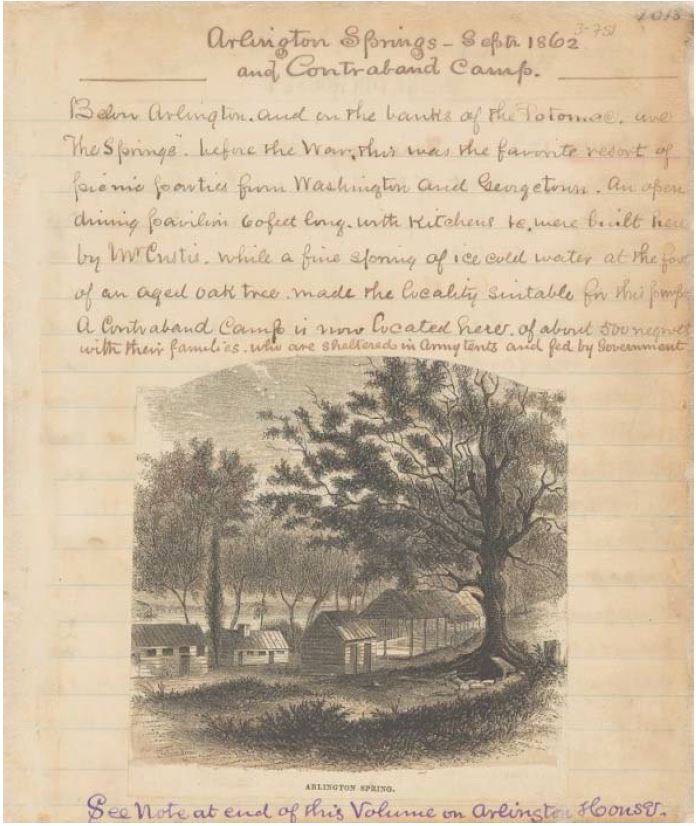
Page from Sneden’s diary describing Arlington Spring, again based on Benson Lossing’s 1853 article in Harper’s Magazine. Sneden also reports the existence of a Contraband Camp below Arlington House, holding 500 former slaves and their families provided for by the US Government. Sneden’s illustration of the inhabitants of the contraband camp is seen in the next image.
Sneden writes in his diary:
“Arlington Springs – Sept 1862 and Contraband Camp. Below Arlington and on the banks of the Potomac are the Springs. Before the war this was the favorite resort of picnic parties from Washington and Georgetown. An open dining pavilion 60 feet long with kitchens to[o] were built here by Mr. Custis while a fine storing of ice cold water at the foot of an aged oak tree made the locality suitable for this purpose. A Contraband camp is now located here of about 500 negroes with their families who are sheltered in army tents and fed by government.”

Sneden’s depiction of contrabands encamped below Arlington House, November 1862.

In December 1862, the headquarters of the Defenses of Washington were moved to the City of Washington, where they occupied a house formerly owned by a Southern sympathizer, at 15th Street & Pennsylvania Avenue. Gen. Heintzelman continued to head the command, with Sneden still assigned to the command as its topographical engineer.
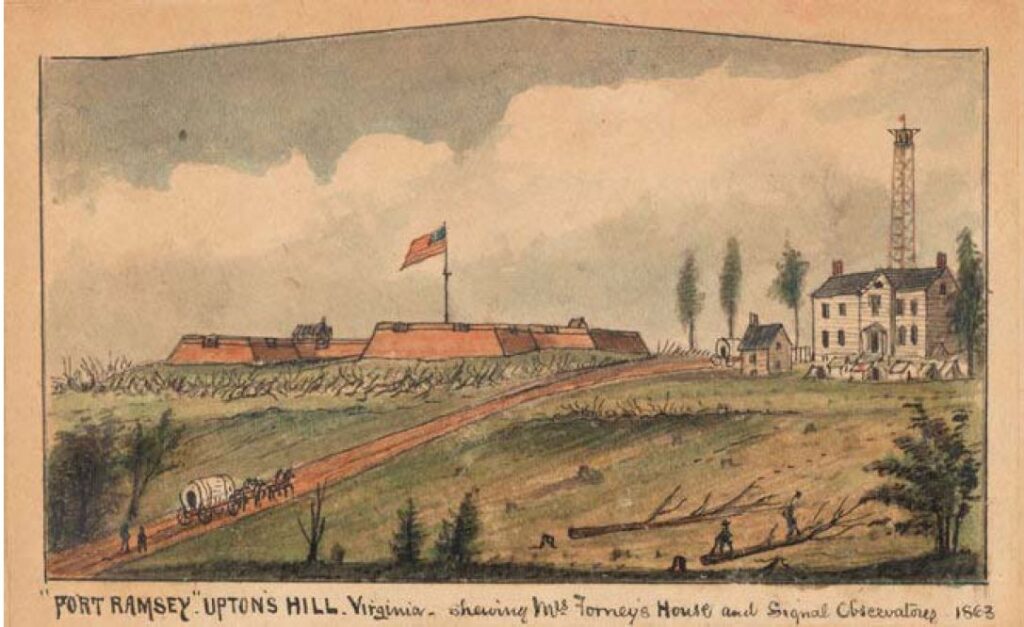
Fort Ramsey on Upton’s Hill, near present-day Seven Corners, in 1863. The fort was manned at the time mainly by Union signal corpsmen. However, immediately after the First Battle of Bull Run in 1861, Upton’s Hill was held by rebel troops, along with the nearby Munson’s Hill overlooking the Leesburg Pike.
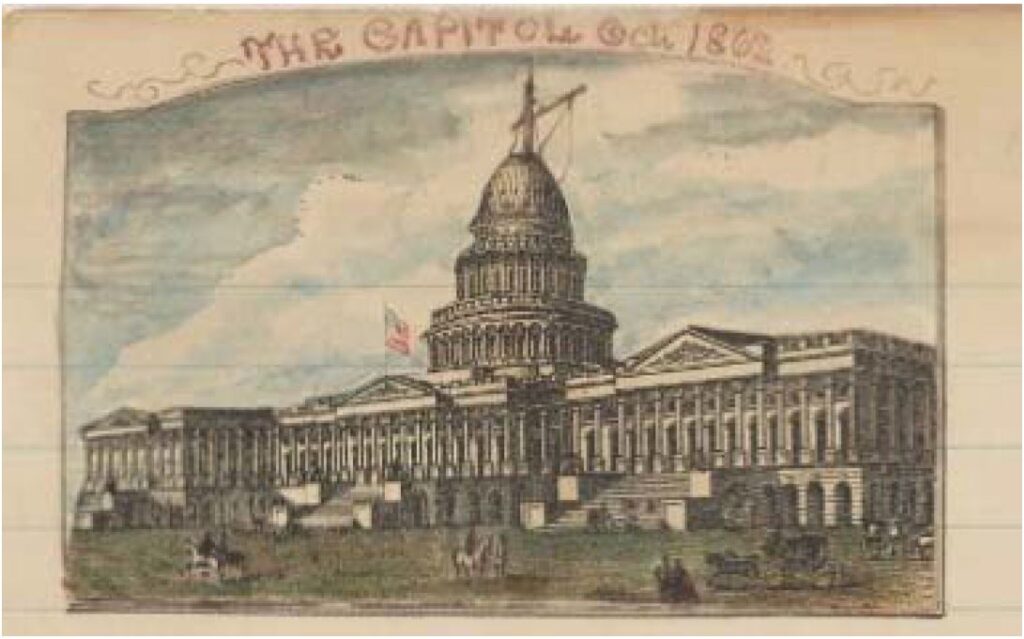

.The Old Capitol Prison where a number of Confederate prisoners of war and spies were held, including Rose O’Neal Greenhow (abt 1814–1864) and her daughter “Little Rose”. The inset photo shows Mrs. Greenhow and her daughter at the prison in 1862. The prison was located at the present site of the US Supreme Court building.

Fort Stevens in NE Washington, in 1863. The fort was attacked in July 1864 by Confederate forces led by Jubal Early.
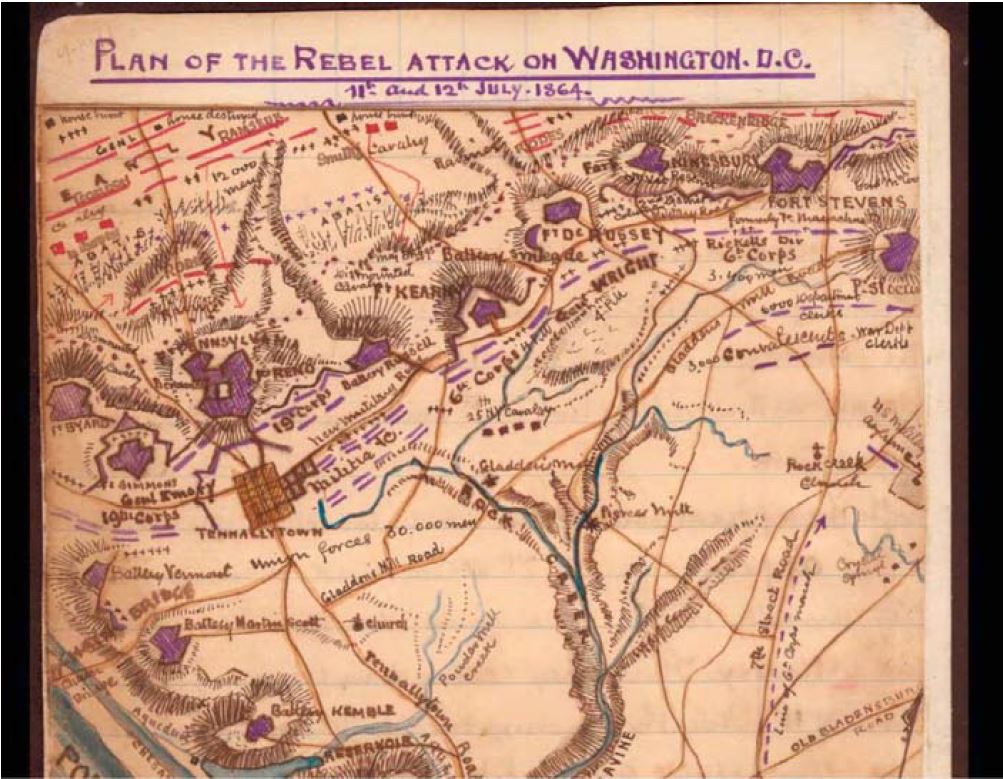
As an aside, this Sneden’s map of the Confederate attack on Ft. Stevens, July 1864. The map might have be originally drawn or sketched by Sneden during 1861-1863, but embellished later, after the War, to illustrate the attack on Ft Stevens. Note Ft Stevens was attacked on the Union right by rebel forces under the command of former US Vice President, John C. Breckinridge, and defended by Union troops from Massachusetts. President Lincoln observed the fighting first-hand from the ramparts of Ft Stevens, but was warned by Oliver Wendell Holmes Jr. (later Chief Justice of the Supreme Court) to crouch down to avoid being shot: “Get down, you fool!” yelled the future Supreme Court Justice. And continuing the aside on the Confederate attack on Ft Stevens in mid-1864, recall the images of the three elderly gentlemen, circa 1918, introduced at the outset.

By now, we are well acquainted with the first gentleman, Robert K. Sneden (1832-1918). The second gentleman is Philip T. Shrewsbury (1851-1922), and the third gentleman is James A.T. Groseclose (1841-1927). Philip Shrewsbury was born in Mercer County, VA (now West Virginia) and did not serve in the Civil War.
James Groseclose, however, was born about 50 miles south of Mercer County, in Bland County, VA. Being of sufficient age, with his two brothers, James served in the Confederate infantry during the War, and in July 1864 his brigade (51st VA Inf) was under the command of Gen John C. Breckinridge during the attack on Ft Stevens.

In August 1863, Sneden tired of his work in Washington, and chose to join the field staff of Gen William French, Third Corps, Army of the Potomac. In October, Sneden was stationed at the Miller house, illustrated here, at Brandy Station, VA. On November 18, learning a major battle (the Battle of Mine Run) was about to begin, Sneden mailed his diaries and drawings home to NY. On November 27, Sneden was captured at the Miller house by “Grey Ghost” John Mosby and a band of his rangers. Under questioning by Mosby and his men, Sneden was pistol-whipped but not seriously injured.

On November 30, Sneden was incarcerated in Crew and Pemberton Prison, a converted tobacco warehouse, in Richmond, VA. The facility was principally for privates and other enlisted Union prisoners such as Sneden, but located very near Libby Prison which was reserved for Union officers in the same warehouse district of Richmond.
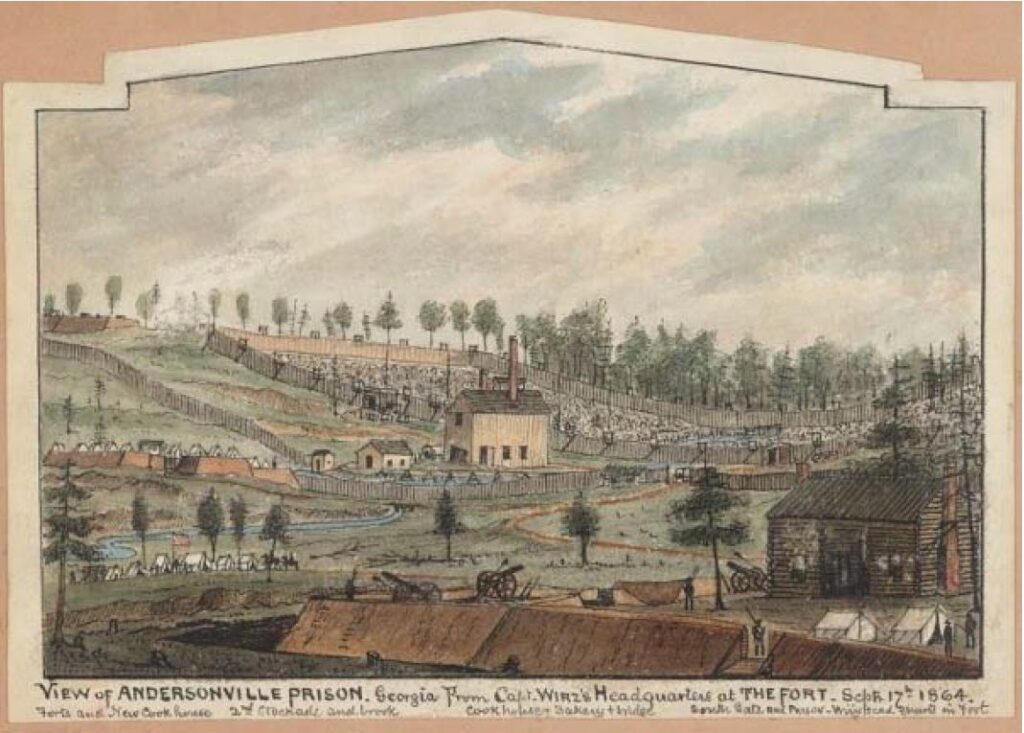
Among Sneden’s most famous illustrations are those he made (on a clandestine basis) of Andersonville Prison, where Sneden was held from February 1864 to December 1864. Shortly after the War ended some of his illustrations and sketches were the basis for newspaper and magazine accounts of the prison’s harsh and brutal conditions. Ultimately, the Swiss-born commandant of Andersonville Prison, Capt. Henry Wirz, was brought before a military tribunal presided over by Gen. Lew Wallace, who also participated in the military trial of the Lincoln assassination conspirators and later penned the popular novel Ben-Hur. Henry Wirz was convicted of conspiracy and murder relating to his command of the Andersonville Prison and was executed at the Old Capitol Prison in November 1865.
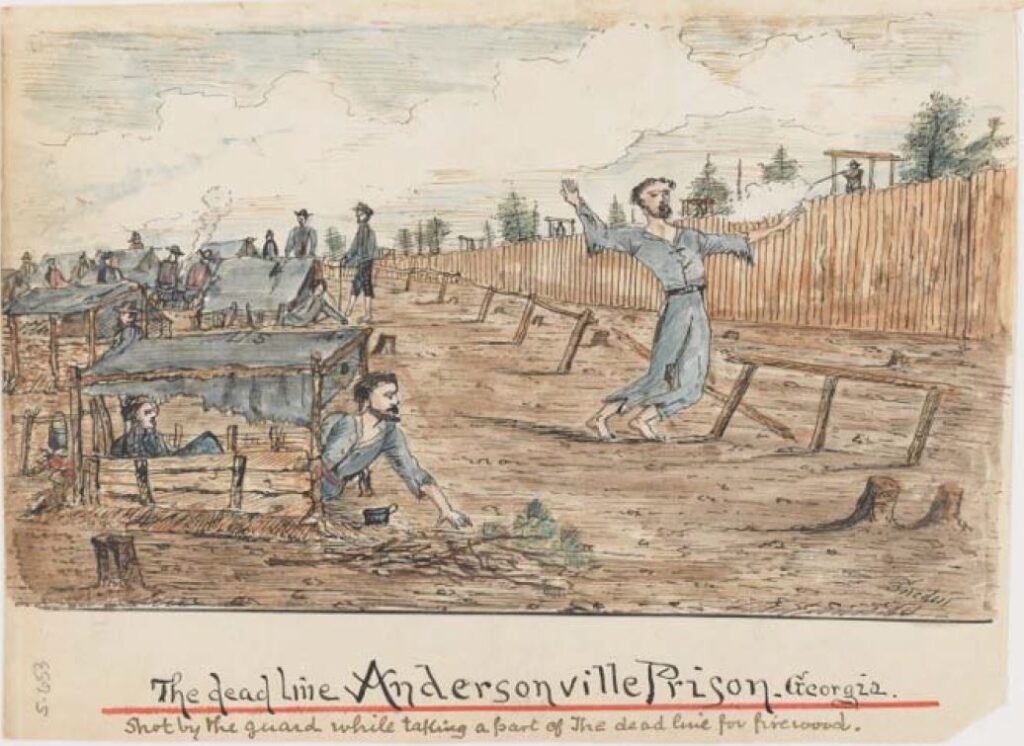
Sneden Chronology 1865-1918
- Jan 1865, Musters out of 40th NY Regt
- Winter 1865, Works for NYC architect Wm Olmsted
- 1877, Moves to Rockland Co., NY
- 1884, Applies for US pension
- 1884-1887, Several Sneden watercolors used as bases for engravings in Century Magazine articles and a book on the Civil War.
- 1905, Enters NY Soldiers and Sailor Home, Bath, NY
- Sept 18, 1918, Dies at Soldiers and Sailors Home, Bath, NY, age 86
- Sept 1918, Buried at National Cemetery, Bath, NY
- 1994, Virginia Historical Society acquires Sneden scrapbook albums
- 1997-1998, VHS acquires Sneden memoir albums

“I leave no posterity, but a GOOD WAR RECORD.”
A memorable quotation provided by Sneden at an elderly age, to a local historian inquiring about the Sneden family whose roots were quite deep in the history of New York state
This article draws heavily on the watercolor landscapes and other images, and the life chronology of Robert Knox Sneden (1832-1918) posted online by the Virginia Historical Society at http://www.vahistorical.org/collections-andresources/how-we-can-help-your-research/researcher-resources/findingaids/sneden-0 (accessed February 2014).
Among other sources, it also draws on Margaret Leech, Reveille in Washington: 1860-1865 (New York: Harper, 1941). Please contact Dean DeRosa at dderosa.va@gmail.com, with any comments or questions. It was originally written in February 14, 2014.
The Arlington Historical Society greatly appreciates Mr. Dean DeRosa’s expertise and time in preparing this article and allowing us to present it here on our website.

